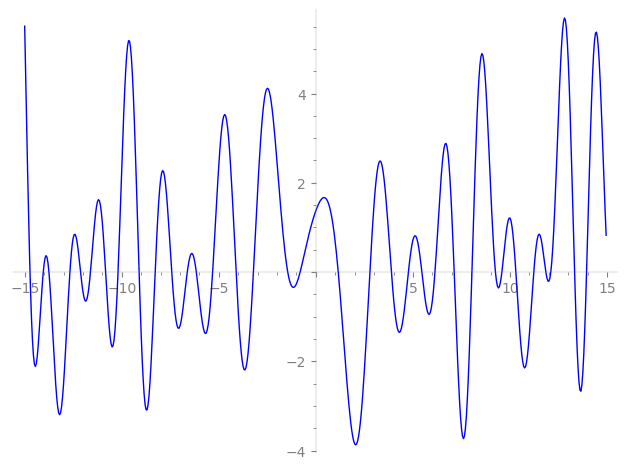| L(s) = 1 | + (−1.66 − 1.66i)3-s − 1.87i·7-s + 2.56i·9-s + (3.29 − 3.29i)11-s + (1.90 + 1.90i)13-s + 2.57·17-s + (5.76 + 5.76i)19-s + (−3.12 + 3.12i)21-s − 7.58i·23-s + (−0.728 + 0.728i)27-s + (6.45 + 6.45i)29-s + 0.799·31-s − 10.9·33-s + (2.69 − 2.69i)37-s − 6.33i·39-s + ⋯ |
| L(s) = 1 | + (−0.962 − 0.962i)3-s − 0.708i·7-s + 0.854i·9-s + (0.994 − 0.994i)11-s + (0.527 + 0.527i)13-s + 0.623·17-s + (1.32 + 1.32i)19-s + (−0.681 + 0.681i)21-s − 1.58i·23-s + (−0.140 + 0.140i)27-s + (1.19 + 1.19i)29-s + 0.143·31-s − 1.91·33-s + (0.443 − 0.443i)37-s − 1.01i·39-s + ⋯ |
\[\begin{aligned}\Lambda(s)=\mathstrut & 1600 ^{s/2} \, \Gamma_{\C}(s) \, L(s)\cr =\mathstrut & (-0.110 + 0.993i)\, \overline{\Lambda}(2-s) \end{aligned}\]
\[\begin{aligned}\Lambda(s)=\mathstrut & 1600 ^{s/2} \, \Gamma_{\C}(s+1/2) \, L(s)\cr =\mathstrut & (-0.110 + 0.993i)\, \overline{\Lambda}(1-s) \end{aligned}\]
Particular Values
| \(L(1)\) |
\(\approx\) |
\(1.378038601\) |
| \(L(\frac12)\) |
\(\approx\) |
\(1.378038601\) |
| \(L(\frac{3}{2})\) |
|
not available |
| \(L(1)\) |
|
not available |
\(L(s) = \displaystyle \prod_{p} F_p(p^{-s})^{-1} \)
| $p$ | $F_p(T)$ |
|---|
| bad | 2 | \( 1 \) |
| 5 | \( 1 \) |
| good | 3 | \( 1 + (1.66 + 1.66i)T + 3iT^{2} \) |
| 7 | \( 1 + 1.87iT - 7T^{2} \) |
| 11 | \( 1 + (-3.29 + 3.29i)T - 11iT^{2} \) |
| 13 | \( 1 + (-1.90 - 1.90i)T + 13iT^{2} \) |
| 17 | \( 1 - 2.57T + 17T^{2} \) |
| 19 | \( 1 + (-5.76 - 5.76i)T + 19iT^{2} \) |
| 23 | \( 1 + 7.58iT - 23T^{2} \) |
| 29 | \( 1 + (-6.45 - 6.45i)T + 29iT^{2} \) |
| 31 | \( 1 - 0.799T + 31T^{2} \) |
| 37 | \( 1 + (-2.69 + 2.69i)T - 37iT^{2} \) |
| 41 | \( 1 + 0.946iT - 41T^{2} \) |
| 43 | \( 1 + (0.829 - 0.829i)T - 43iT^{2} \) |
| 47 | \( 1 + 1.52T + 47T^{2} \) |
| 53 | \( 1 + (-6.97 + 6.97i)T - 53iT^{2} \) |
| 59 | \( 1 + (6.84 - 6.84i)T - 59iT^{2} \) |
| 61 | \( 1 + (6.87 + 6.87i)T + 61iT^{2} \) |
| 67 | \( 1 + (-3.73 - 3.73i)T + 67iT^{2} \) |
| 71 | \( 1 + 9.34iT - 71T^{2} \) |
| 73 | \( 1 - 0.886iT - 73T^{2} \) |
| 79 | \( 1 + 3.07T + 79T^{2} \) |
| 83 | \( 1 + (-0.989 - 0.989i)T + 83iT^{2} \) |
| 89 | \( 1 + 10.0iT - 89T^{2} \) |
| 97 | \( 1 + 7.16T + 97T^{2} \) |
| show more | |
| show less | |
\(L(s) = \displaystyle\prod_p \ \prod_{j=1}^{2} (1 - \alpha_{j,p}\, p^{-s})^{-1}\)
Imaginary part of the first few zeros on the critical line
−9.108072125894051832405273376288, −8.279390160403590794471449512818, −7.42499933143613336075183305398, −6.62520570845084823495778261724, −6.16036169060653594847200138817, −5.31922662020622159536685656312, −4.10953944338986652094301156600, −3.21858942015129556769072004453, −1.45075850886780049613113237678, −0.812595482325958065677987905483,
1.15028034845395104737637889627, 2.78029623756262779024007444155, 3.88962135081767423978711179291, 4.76480345159962519897689218759, 5.45925603042074075578361616523, 6.13291932845330798743943786217, 7.12274696940992561735442185347, 8.036761405125725983831458651373, 9.247610153911717075839417274226, 9.579848969248661807953345838444

